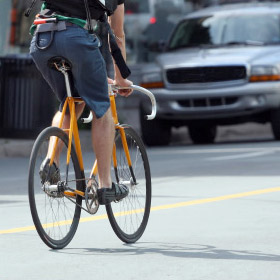Bike Accidents: Watch Out for the Left Cross, the Right Hook and the Open Door
Written by: Ken Selander Category: Bicycle Accidents, Safety Whether it’s for business or pleasure, bicycling is a popular activity in the state of Washington — particularly in the Seattle area.
Whether it’s for business or pleasure, bicycling is a popular activity in the state of Washington — particularly in the Seattle area.
About 36 percent of the city’s 520,000 residents regularly engage in recreational biking, and between 4,000 to 8,000 commute to work every day, according to the Seattle Department of Transportation.
It’s no wonder: Seattle is one of the most bicycle-friendly cities in the country, with 28 miles of shared-use paths, 22 miles of on-street striped bike lanes and 90 miles of signed bike routes.
And it could get even friendlier to bicycle travel in the future: The Seattle Bicycle Master Plan calls for tripling bicycling in the city by 2017 by adding features such as buffered bike lanes, which provide a striped cross-hatched area between bicyclists and motorists on city streets, and bike boxes, which give bicyclists a place in front of motor vehicles while waiting at a stoplight.
The unavoidable reality, however, is that as more bicyclists hit the roads, more bicyclists will get hit by motor vehicles — usually because someone was taking a dangerous risk or simply wasn’t paying close enough attention.
In fact, there were more than 1,300 accidents involving bicyclists in the state of Washington in one recent calendar year, according to the Washington State Department of Transportation. The highest percentage of accidents occurred on streets and accounted for nearly half of all of the state’s non-motorist fatalities.
Here are three of the most common types of bicycling accidents and how to avoid them:
The Left Cross
This accident occurs when a bicyclist approaches an intersection and a motorist entering the intersection from the other direction either crosses in front of the bicyclist or plows into him or her. Either way, the bicyclist is bound to suffer serious injuries in the collision.
The best way to avoid this accident is to stay alert as you get near the intersection. Even if you have the right of way, get ready for evasive action if there is any hint that the motorist isn’t yielding the right of way.
You can also try riding a little more to the left than usual and indicate your intention to cross through the intersection and take the right of way. Moving to the left also gives the motorist a better chance of seeing you.
The Right Hook
This type of accident involves recklessness as much as it does carelessness. It occurs when a motorist speeds past a bicyclist on the left and then tries to make a right turn in front of him or her. The motorist might have misjudged the distance in front of the bicyclist or the speed at which the bicycle was traveling.
How can a bicyclist avoid this? A good idea is for the bicyclist to ride with a mirror that will allow a check of traffic coming from the rear. However, the bicyclist should still make sure to stay focused on what’s in front, not behind, when going through any intersection.
As with the left cross, it also helps to ride to the left in your lane, which should signal the cyclist’s intention to take the right of way and cause the motorist coming from behind to slow down and wait before turning to the right.
The Open Door
This happens when a motorist getting out of a car opens the door right in front of a bicyclist. Both the bicyclist and the motorist can end up suffering very serious injuries in such an accident.
The best way to avoid this type of accident is to simply ride to the left and don’t “hug” the curb. The bicyclist should estimate how much space is needed for an average-sized car door to fully open without coming into contact with the vehicle.
Other Safety Measures
In addition to the specific safety measures above, a bicyclist should always wear a helmet — even though it is not required by law in all counties of Washington State — and should always wear bright clothing that will attract motorists’ attention.
Also, when traveling at dusk or at night, a bicyclist must use proper front and rear lights and reflective gear, which give motorists an even better chance of seeing them.

